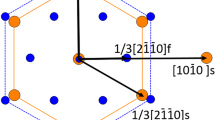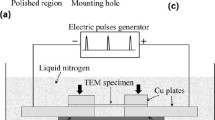Abstract
Dislocation structures in Al-Cu thin films have been studied by transmission electron microscopy (TEM). We have observed that the contrast of interface dislocations disappears in the electron beam. We assume that the contrast dissolution is due to the spreading of the dislocation core at the crystalline/amorphous interface or due to a diffusive movement of the dislocation through the oxide. In any case, the relaxation is assumed to be controled by irradiation induced diffusion. As a consequence, the short range stresses and at least partly also the long range stresses of the dislocations relax. This relaxation changes the interaction force between dislocations and may thus significantly affect the mechanical properties of thin films. It is concluded that interaction between interface dislocations may not be responsible for the high temperature strength of aluminum films.
Similar content being viewed by others
References
W.D. Nix, Mater. Sci. Engng. A 234–236, 37 (1997).
W.D. Nix, Metall. Trans. A, 20 A 2217 (1989).
A.P. Sutton and R.W. Balluffi, Interfaces in Crystalline Materials, (edited by R.J. Brook, A. Cheetham, A. Heuer, P. Hirsch, T.J. Marks, J. Silcox, D.A. Smith, M.V. Tirrell and V. Vitek), Clarendon Press, Oxford (1995).
W. Bollmann, Crystal lattices, interfaces, matrices, privately published, Geneva (1982).
C. Somigliana, Att. Accad. naz. Lincei 23, 463 (1914); 24, 655 (1915).
A.E. Romanov, W. Pompe and J.S. Speck, J. Appl. Phys. 79, 4037 (1996).
P.H. Pumphrey and H. Gleiter, Phil. Mag., 30, 593 (1974).
R.A. Varin, Phys. Stat. Sol. (a), 52, 347 (1979).
A.A. Nazarov, A.E. Romanov, and R.Z. Valiev, Scripta metall. mater., 24, 1929 (1990).
C. Solenthaler, Phys. Stat. Sol. (a), 149, 21 (1995).
J.P. Hirth and J. Lothe, Theory of Dislocations, 2nd ed. (Krieger Publishing Company, Malabar, 1982), p. 3; p. 220.
Y.-C. Joo, P. Müillner, S.P. Baker and E. Arzt, in Mater Res. Soc. Symp. Proc., 473, 409 (edited by J. Clement, R. Keller, K. Krisch, J. Sanchez and Z. Suo MRS, 1997).
L. Reimer, Transmission Electron Microscopy (Springer, New York 1984), p. 427; p. 445.
F. Kroupa, Key Engng. Mater. 97–98, 377 (1994).
P. Millner, Scripta metall. 33, 1181 (1995); 35, 903 (E) (1996).
A.E. Romanov, phys. stat. sol. (a) 63, 383 (1981); (private communication).
S.P. Baker, R.-M. Keller, and E. Arzt, Mater. Res. Soc. Symp. Proc. (Fall 1997), this volume.
A.E. Romanov, T. Wagner, and M. Rtihle, Scripta mater (submitted July 1997).
Author information
Authors and Affiliations
Corresponding author
Rights and permissions
About this article
Cite this article
Müllner, P., Arzt, E. Observation of Dislocation DisAppearance in Aluminum Thin Films and Consequences for Thin Film Properties. MRS Online Proceedings Library 505, 149–154 (1997). https://doi.org/10.1557/PROC-505-149
Published:
Issue Date:
DOI: https://doi.org/10.1557/PROC-505-149




